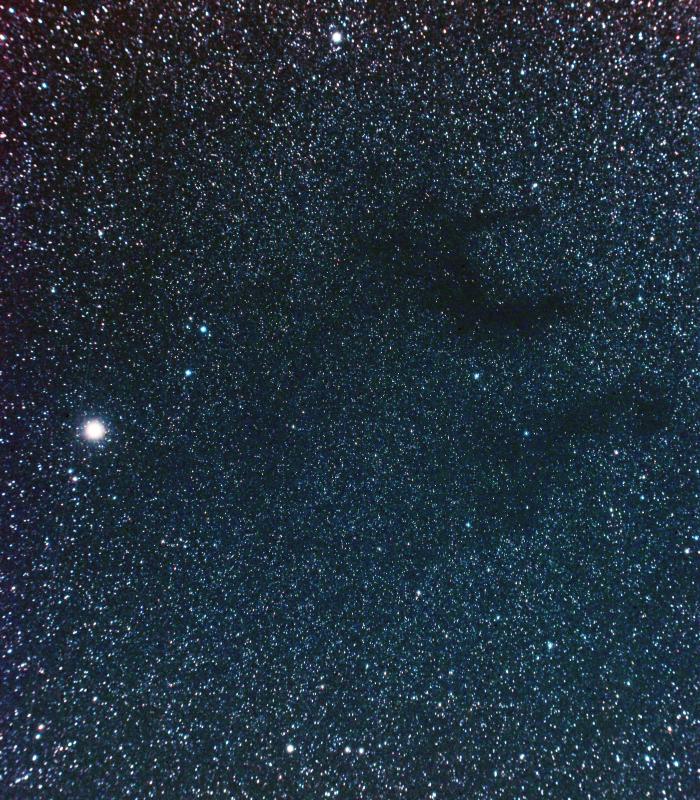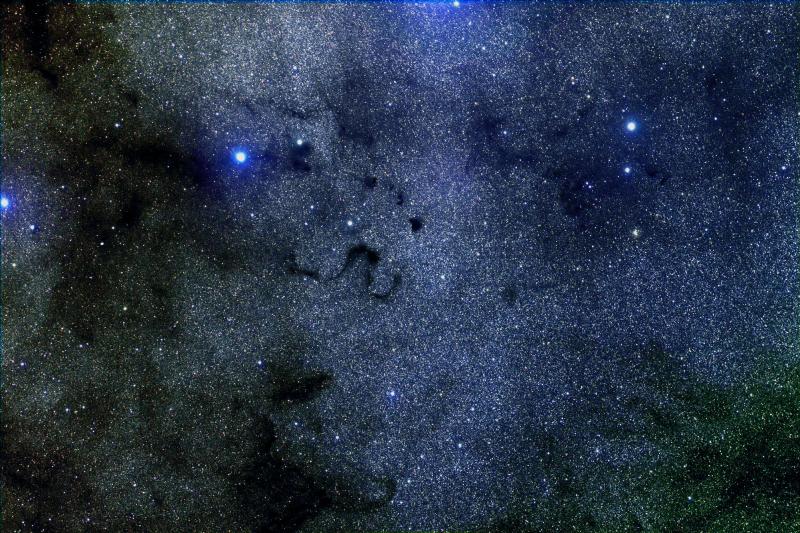2018 August 27
Observer’s Challenge – Dark Nebulae of Summer

E.E Barnard’s “Dark Markings” against the bright Milky Way background are now known to be relatively dense clouds of hydrogen and gas. These are the Molecular Clouds that will form stars and planets, and therefore us. Although perhaps less eye-catching than the excited gas of emission nebulae or ghostly blue reflection nebulae, they are fascinating in their own right. They are well worth observing but can be a challenge. Here are three for summer.

“Barnard’s E”: Barnard 142 and 143.
The easiest of the three challenges is “Barnard’s E” in Aquila. Most dark nebulae are difficult to see visually, and this is no exception, but it is positioned very favourably for location, being just to the west of Tarazed (gamma Aquilae) the star just north of Altair. E.E Barnard left his first initial here, there being a prominent “E” formed from Barnard 142 and 143. It can be easily photographed but can be a challenge visually in a bright summer sky in Britain, but may just be detected in binoculars from a dark location in late summer or better still in autumn.
The Seahorse nebula
The second challenge is the celestial Seahorse. Barnard 150 (LDN 1082) in Cepheus rides high above the hazy murk of the summer so is well placed for UK observers until late autumn. This is one for the imagers, as the Milky Way is less conspicuous here, although the star field is pretty.
_0.jpg)
The nebula is a sequence of irregular of dark filaments a degree and a half south east of eta Cephei; or if you prefer, 15 minutes of RA due east of the well-known “Fireworks” galaxy, NGC 6946. Quite long exposures should reveal the fanciful “Seahorse” shape. The thinner western aspect is in fact more prominent that the thicker eastern “head” which seems to be burrowing into slightly more diffuse darkness. The whole Seahorse wanders in front of the Milky Way for some 1.5°. A pair of 9th magnitude stars guide to the tip of the tail, and three close stars of around 8th magnitude in a line mark the neck of this delicate target.
[details about Peter Carson’s image (Barnard 150): Televue TVNP101 100mm APO refractor 540mm fl. Starlight Lodestar autoguider on G11 Mount. SBig ST8300M CCD camera. Images acquired in Maxim DL ProTrue Tech RGB colour filters. 2hrs 25mins total exposure. LRGB image: Luminance = 100 mins 1×1; Red = 15 mins 1×1; Green =15 mins 1×1; Blue = 15 mins 1×1. All sub exposures 300 seconds at -20 deg C.]
The Snake nebula: Barnard 72

The Snake itself is a small S-shaped mark against the bright rich Milky Way background, and is surrounded by an archipelago of small dark clouds, one of the most opaque being Barnard 68, William Herschel’s “Hole in Heaven”. The Snake itself is some 2-3 arc-minutes in thickness along its length and occupying around 6 arc-minutes so a wide field eyepiece is handy. Too narrow a field will lose the effect. In the same field is the very opaque B68 at the northern tip of the Snake’s “S”. The dark nebula complex is thought to be associated with the Rho Ophiuchi complex near Antares and some 600 light-years distant, making these some of the closest dark molecular clouds to us.
In fact over 20 Barnard nebulae can be located within a five degree square area nestled above the huge Pipe Nebulae that sprawls in the south-eastern aspect of Ophiuchus. Its 5° x 3° is best captured with a camera lens between 50mm and 135mm from a dark site.
Nick has been a keen amateur for many decades and was Section Director of the Deep Sky Section 1992 to 2003.
Please submit any observations of dark nebula to the BAA’s Deep Sky Section, and upload them to your members page.
[Thumbnail image of Barnard 142 and 143 by David Adshead, 31/12/2009]
| The British Astronomical Association supports amateur astronomers around the UK and the rest of the world. Find out more about the BAA or join us. |
